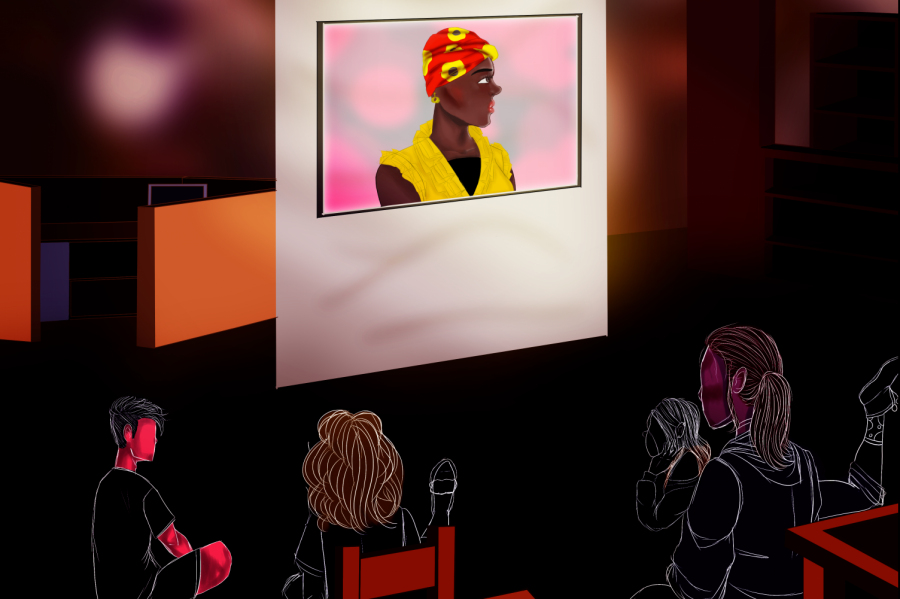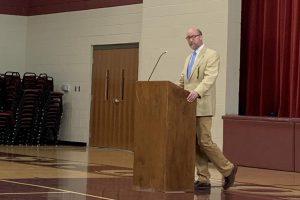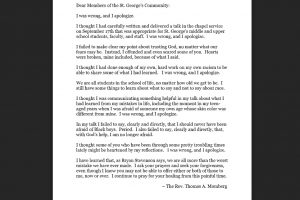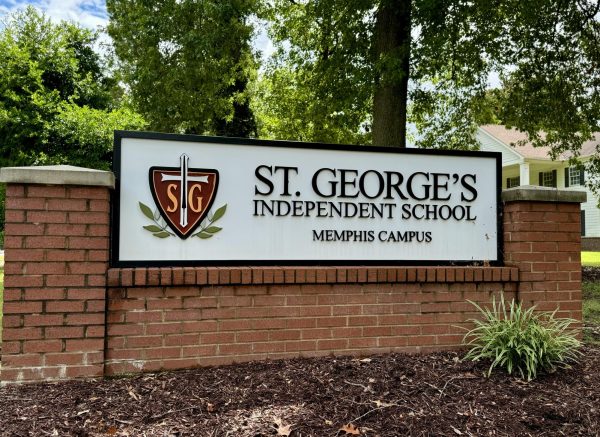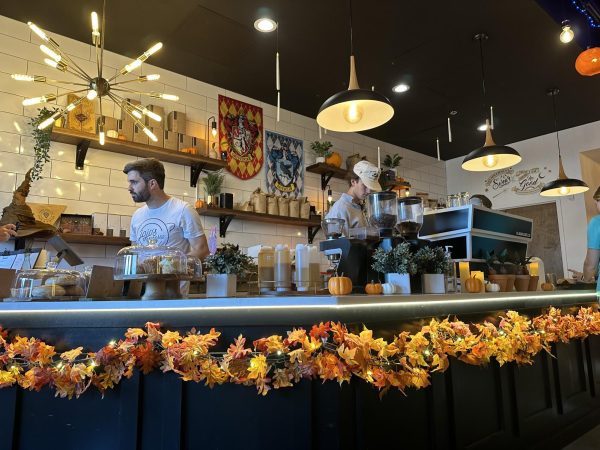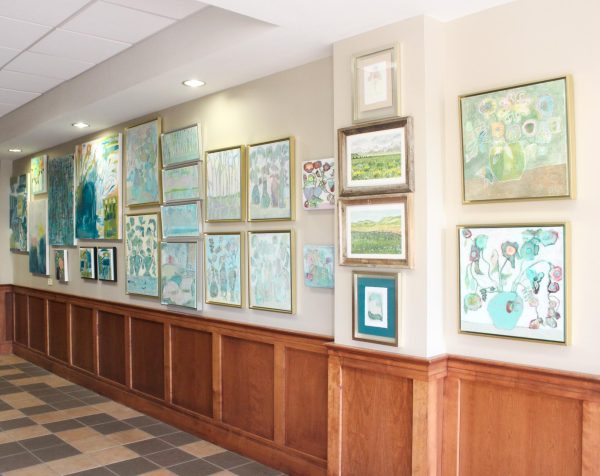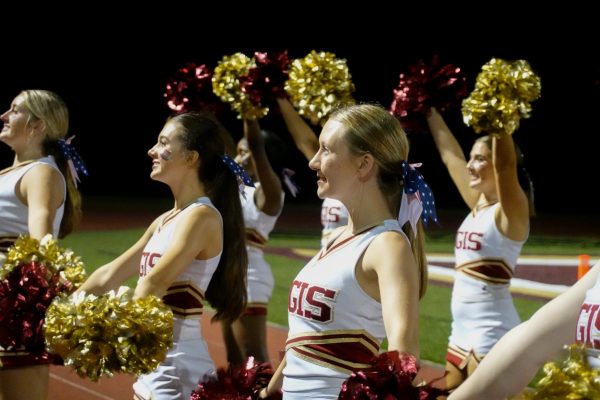How Do We Heal?
Students and faculty take the lead in the wake of racial tensions
Photo: E’nissa Golden
In this illustration, students gather in the library to watch Chimamanda Ngozi Adichie’s TEDtalk on the danger of the single story. The Lodge was asked to refain from photography during the Day on Pause in order to make students feel more comfortable participating.
In the dawn of the school year, St. George’s has faced challenges that have prompted difficult discussions. Racial tensions have thrust the school into the public eye and pushed its community to face them head on. How exactly does a school deal with this kind of conversation? We’re finding out.
On Tuesday, Sept. 17, the school day was interrupted so that Head of School Mr. Ross Peters and Chaplain Mrs. Jessica Abell could deliver an apology in the wake of a chapel talk given that morning by the Reverend Thomas Momberg of Holy Trinity Episcopal Church, which contained troublingly negative characterizations of young black men.
Concern, anger and disappointment defined the response of much of the student body in the aftermath of the initial sermon, and many teachers took class time to allow students to voice their thoughts. Just hours later, the students and faculty were summoned back to the gym to hear apologies from Mr. Peters and a tearful Mrs. Abell.
“It was wrong to stereotype young black men. It was insensitive. It was not helpful to our community. It is not what we believe,” Mr. Peters said. “At St. George’s, differences are sources of strength. They build upon our shared experiences and deepen our community. And they enhance our growth as helpful, caring, contributing human beings.”
Visibly crying, Mrs. Abell voiced her own feelings about the incident.
“I am heartbroken by this morning,” Mrs. Abell said. “I am heartbroken for all of us.”
The Lodge reached out to Rev. Momberg in the hours following the sermon and received an apology letter on Oct. 3.
“I failed to make clear my point about trusting God, no matter what our fears may be,” wrote Rev. Momberg. “Instead, I offended and even scared some of you. Hearts were broken, mine included, because of what I said.”
In the days that followed the initial sermon, Associate Head of School Mr. Will Bladt spoke about the pain the incident caused.
“It breaks my heart that people had to be in that space and experience any questions about what he meant,” Mr. Bladt said. “I think some people were giving him the benefit of the doubt. I think he was talking about the fact that his thoughts at that point in time in his life were wrong, but he didn’t come out and say [it], and so then it left other people wondering.”
Mr. Bladt did not place any blame on those, like Mrs. Abell, who have responsibilities over the all-school chapel services, as Rev. Momburg’s remarks came as a surprise to them.
“I feel like those charged with [vetting the talk] did their due diligence and communicated proactively about what was OK and what was not,” Mr. Bladt said. “The article that had come out [in the Commercial Appeal] was a known piece to this person [Rev. Momberg], and the fact that they proceeded with the talk that they did was disappointing and infuriating.”
Mr. Bladt was referencing a piece published on Aug. 28 by Daniel Connolly in the Memphis daily newspaper the Commercial Appeal about an incident that occurred in the middle school last spring involving racial slurs directed at a teacher of color. Many members of the St. George’s community said they felt the timing of the chapel made it all the more troubling, particularly for students of color.
“We still had that Commercial Appeal thing hanging over our heads,” sophomore Iris Delahoussaye said. “That chapel talk on top of it was just another gut punch.”
Junior Alicia Hardrick agreed. “I just feel like with everything that’s going on with school right now, like with this article that came out, that this did not make it any better,” Hardrick said. “This whole apology thing [from Mr. Peters and Mrs. Abell], it’s a step towards the right direction, like doing something about it right after it. But the fact that he [Rev. Momberg] even came to our school and said that to us really hurts still.”
Recent events may have brought matters to a head, but racial tensions prevalent across the nation have been manifested at St. George’s before.
Last year, Lodge reporter Cary Robbins covered some of the challenges faced by students of color at St. George’s in “Colors you can’t ignore.”
“[Racism is] a very real thing,” current senior Jada Hines said in that article. “Just because we’re more sheltered in a private school doesn’t make it invisible. It’s still there. It’s still going to be there for a long, long time. And it may affect some people more than others.”
In a Sept. 1 email to the larger school community following the publication of the Commercial Appeal article, Mr. Peters acknowledged that while racism is widespread in American culture, the school can and should do better.
“I have heard many people say, when offering some comfort during this trying time, that incidents of racist or hateful language occur in all corners of our national culture,” he wrote. “While I appreciate all offers of support, we should not find this comforting. St. George’s has so often risen, and will continue to rise, to a far higher standard than the mean of the larger culture.”

The St. George’s community is undergoing a process of healing after a tumultuous start to the year.
But how do we do that?
The incident during chapel served as the catalyst for a formal effort to address serious issues. Students took immediate action to repair the recent damage. One of the most outspoken among them was senior and active member of MySpaceAlliance club Keiara Baker. She emailed administrators the night after the chapel talk.
“I emailed [Upper School Dean of Students] Ms. [Kalyn] Underwood, [Upper School Director of Student Life] Ms. [Emmy] McClain and [Upper School Director] Ms. [Pamela] McCarthy, and I was like, ‘Basically our school needs a break,’” Baker said. “To me it was a huge distraction for all that to be happening and then us to go back to classes.”
Baker initially wanted the school to act immediately to address the chapel talk incident.
“I met with Ms. McClain. I wanted it to be literally the next day,” Baker said. “I knew deep down that that was a lot. But Ms. McClain, Ms. Hardy, Ms. Underwood, Ms. McCarthy, a lot of different teachers in our school were working really hard on it. The first night, I heard them saying that that they stayed at somebody’s house till 1 am. I literally saw my teachers working hard to get it done. They were missing lunch.”
Baker wasn’t the only one calling on administrators and teachers to take action. Athletes, student government, members of the Honor Council and individuals all spoke up to insist that something be done.
As a result, on Monday, Sept. 23, St. George’s students participated in a day of conversation and communication, a “House Day on Pause,” to take a break from normal activities and heal from the recent controversies.
“We found that teachers were saying that ‘Hey, I have a bunch of kids who asked if we could do something like this, and I had another group of kids who asked for something like that,’” said Ms. McClain. “We pulled them all together to say ‘Hey guys, we’re thinking we’re going to do something like this.’ It was cool to see them looking around the room and being like ‘Oh, your group cares about this?’ It was a cool moment to see that [realization].”
Instead of four classes, there were four activities that the school houses rotated through until lunch.
In the senior dining hall, students took a quiz to find their love languages, watched a video on the difference between empathy and sympathy and acted out examples to practice empathetic responses.
In the Agape Chapel, Reverend Cedrick Jackson gave a sermon about an encounter with racist remarks when he was younger, and students participated in a few activities focused on inclusion and exclusion.
In the library, students watched a TEDtalk by Chimamanda Ngozi Adichie and then used the active listening skills they learned to discuss pictures and photos in small groups.
In the Slatery Gym, advisories grouped up to play a game called the “Box Talk” where students stepped into a box if they self-identified with a statement read by one of the game’s leaders in order to recognize the many underlying connections between students that are not easily seen.
After a lunch break, students gathered together by grade level to break down what they wanted from their peers and faculty and what they needed for a successful year.
During the time usually occupied by x-block, the student body had a release to end the day, choosing between study hall, meditation and mindfulness, coloring, journaling and reading, a MySpace Alliance storytelling meeting, basketball and other recess activities.
For Ms. McClain, it came as no surprise that teachers responded to student calls for action that resulted in taking the House Day On Pause.
“Teachers are very empathetic people, and that’s why they choose this profession: because they want to nurture kids,” Ms. McClain said. “We chose to be here rather than other independent schools. We’re willing to do the hard work. It’s in our mission to do the hard work that’s needed in the area of inclusion, diversity, equity and all those things. It’s needed, and this is the school that has purposefully said that we are trying to get there. But it’s super hard. On some things we’re not going fast enough, and on other things to some people it feels like we’re going way too fast. There’s a wide range of emotions.”
While students were generally happy to have their concerns addressed, not all thought the day went far enough.
“I think it was a little watered down. It was too diluted for me,” junior Kynnedy Armstrong said. “I think a lot of people who were most affected by the situation that occurred with the racial incident, we all expected something that would have more impact, that would go deeper into the issues that our school has had for many, many years. While we expected something that was deeper, we got something that was very on the surface and not enough. I was left kind of unfulfilled.”
Sophomore Iris Delahoussaye said she also felt that the day’s conversations could have delved deeper.
“I feel like they were trying to get an open discussion about it,” Delahoussaye said. “But, I feel like they were, a lot of [the] time, snaking around the issues.”
Junior Dean Campell agreed that the day needed to go much further than it did, but he said he found the inclusivity activity in the chapel productive.
“It went the most in depth in terms of issues that we’re facing,” Campbell said. “We do face quite a bit of exclusion at our school and in our school community. I think that was a pretty effective way of voicing to everybody because everybody had to sit there and everybody had to listen – hopefully they had to listen – to what people needed and how people felt excluded and how people should be included in the future. I think that’s important.”
However, he stressed that more is needed. He has advocated specifically for a diversity council and hopes that the administration will continue being more responsive to student proposals.
“With the diversity council, it has been proposed in the past at a junior retreat, but it got denied,” Campbell said. “But I think it is just another idea that we need to keep pushing, and I think will hopefully get pushed through. Part of me thinks that it’s not going to happen and it’s never going to happen. But we’re still trying at least, trying to find something that’s going to work, something that’s going to stick, something that’s going to create some actual change at the school.”
While some students felt the day did not go far enough, others may have felt that it wasn’t needed at all. Ms. McClain acknowledged the possibility that some students may have felt the day was wasted.
“Some students are probably like, ‘I want to go to my classes, and I want to do my academics. Then I want to go home, and that’s why I’m here,’” she said. “For those kids, they may not need it, but there was a big enough group of students that said that they really needed this right now. It was reasonable that they were asking for the pause, so we took it.”
Upper School English teacher and MySpace Alliance club sponsor Ms. Leanne Ricketson, who helped with planning the day and helped to lead one of the activities, stressed that the range of student readiness and understanding presented a challenge.
“If I’m teaching an English lesson and I’m looking out at 17 faces, they’re in 17 different places,” Ms. Ricketson said. “And we can group however we want to group and we can differentiate [and] scaffold however you want to differentiate and scaffold, but at the end of the day, it’s still 17 distinct places. So we have all these students, and they are each in a unique position.”
This also crosses over to social education, as in the context of the House Day on Pause.
“I think my answer to those who say that this didn’t go deep enough for me,” said Ms. Ricketson, “is that it didn’t go deep enough for a lot of kids, [but] it may have gone too deep for some.”
For students and faculty, one common theme was that the work begun during the House Day on Pause should not stop there. Ms. Ricketson emphasized that the faculty and administration have a plan going forward.
“Now that Monday [the House Day on Pause] has happened, we’re going to get feedback. We’re going to read those notecards that y’all wrote us, we’re going to listen to kids,” Ms. Ricketson said in reference to the notecards that students wrote expressing suggestions for further actions the school could take. “I’m going to take information from MySpace Alliance. We’re going to circle back up and we’re going to say, ‘These are the recurring trends.’ And we’re going to figure out when that happens.”
Whatever happens, it seems likely that MySpace Alliance will have a role to play. Senior Aiden Curran started the club, whose mission is “to provide a safe space where students from all walks of life can share their experiences,” last year.
Faced with disruption in their academics and emotional well-being, many students, including Armstrong, turned to MySpaceAlliance club for support.
“Our leaders in that club, if you have an idea, an action to take, they will take it to authority. That’s a big reason this whole Day on Pause thing happened,” Armstrong said. “[Baker] had an idea, and she introduced it, and we had been talking about it in MySpace. It just goes to show how much you can do when you have a community of people ready to take action, talking it out, coming up with ideas on how to do things. ”
In addition to seeking conversation in official clubs like MySpaceAlliance, some students, including junior D.J. Loynes, are finding informal community in the wake of recent challenges.
“Fortunately, I think I’ve seen a lot of people unite together against all of the negativity that’s been arising,” Loynes said. “Friendships have been forming or people [are] encouraging each other or even students [are] saying to other students, ‘Hey that’s not okay. You shouldn’t do that.’ It’s almost developed a sense of maturity in certain members of the student body.”
It’s a maturity that he thinks students will need going forward.
“I would hope that my classmates are very wise in how they handle this. Many are capable leaders and are in student government or in MySpace Alliance,” Lyons said. “I hope that they are wise about how they handle it. I hope it’s not just based on impulse or a quick knee-jerk reaction.”
While students are taking the lead in healing their community. Armstrong sounded a note of caution.
“With a lot of the things that have happened, it’s student led. The people in MySpace are the frontrunners of making a lot of these things happen, so you’ve got so much weight and burden on students,” she said. “It affects mental health as well. It puts stress on students because instead of worrying about their schoolwork or their well-being, they’re just trying to figure out how to make their school environment a better place when that shouldn’t be a student’s job. That should be a professional’s job. That’s the administration’s job.”
Campbell likewise emphasized that there is a very long road ahead and that the challenges facing students, faculty and administration are significant, but he acknowledged that there has been some forward progress.
“Even though it is baby steps,” he said. “It’s still a step towards something.”
Full Disclosure: Keiara Baker is a member of the staff of the Lodge.
Miles Masters, Cary Robbins, Madeline Sisk and Callie Hollis contributed to the reporting of this story



